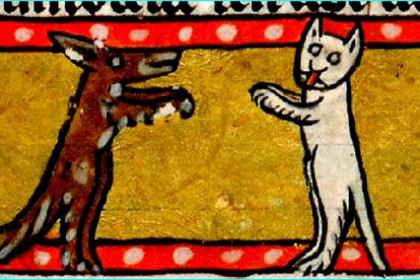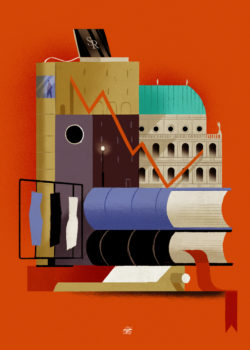
Soon the Fathers of the newborn Church decided to get rid of the Mothers of ancient cults, fearing that they could hide assertive aspirations that could undermine their power. To ensure that charges of idolatry would find greater foundation, Christian theologians established a division between good and evil even in animal world and cat ended up in the group of animals considered incarnation of the Devil becoming a symbol of heresy: its untamable nature evokes the condition of heretic intolerant to orthodoxy of doctrine. Alan of Lille will force the etymology of the word cathar just to make it derive from Medieval Latin catus (cat) so that a rumor like “it is said they worship the devil in the guise of a cat” became theology.
At this point, medieval symbolic moves in uncharted waters since the patristic must find a moral dimension to cat that was not there before. Isidore of Seville introduces the cat in medieval bestiary and its play with the mouse will become an exemplum of devil playing with human souls at the moment of death. So that will be depicted in stalls [image 1] and in reliefs [image 2] of cathedrals, with a rat in its mouth, until the papal bull “Summis Desiderantes“, issued by Pope Innocent VIII, establish the link witch-cat identifying among the “symptoms” of witchcraft the taking care of cats as if they were family members [images 3 and 4].
But not all of the Middle Ages is dotted with ailurophobic with felinicide tendency, such as Gregory IX, who will order to exterminate them all. Cats, as many pagan texts saved from destruction at the hands of really knowledgeable patrists who invented Christ foreshadowing out of thin air for Knowledge sake, will be preserved thanks to amanuensis monks and miniaturists who portray them in manuscripts [images 5 and 6], to Masters who immortalize them in cathedrals [images 7 and 8] and trouvères that make of them heroes of roman such as Renart, in which cat Tibert gets angry with clergy [image 9]. The cat soon became companion of these artists and was able to leave its signature on more than one manuscript [image], as evidenced by the note of a witty scribe on a code of ‘400 preserved in Cologne [image 11] “a cat has urinated here during the night. Might be cursed the bad cat who urinated on this book overnight in Deventer. And beware from leaving books open at night, where cats can come.”
To be continued…
 English
English  Italiano
Italiano 



